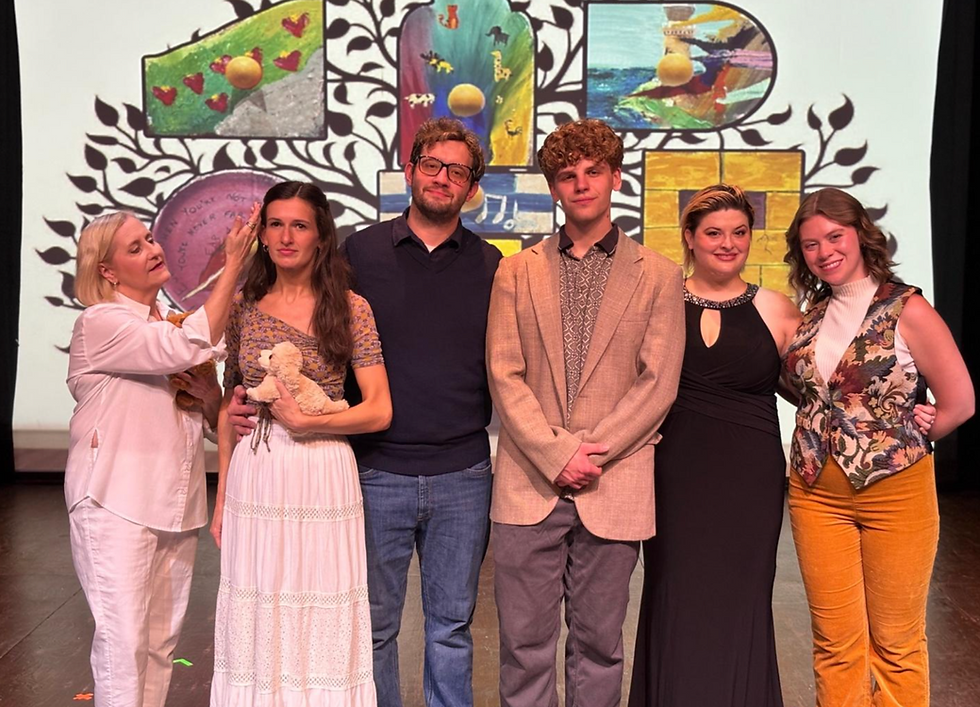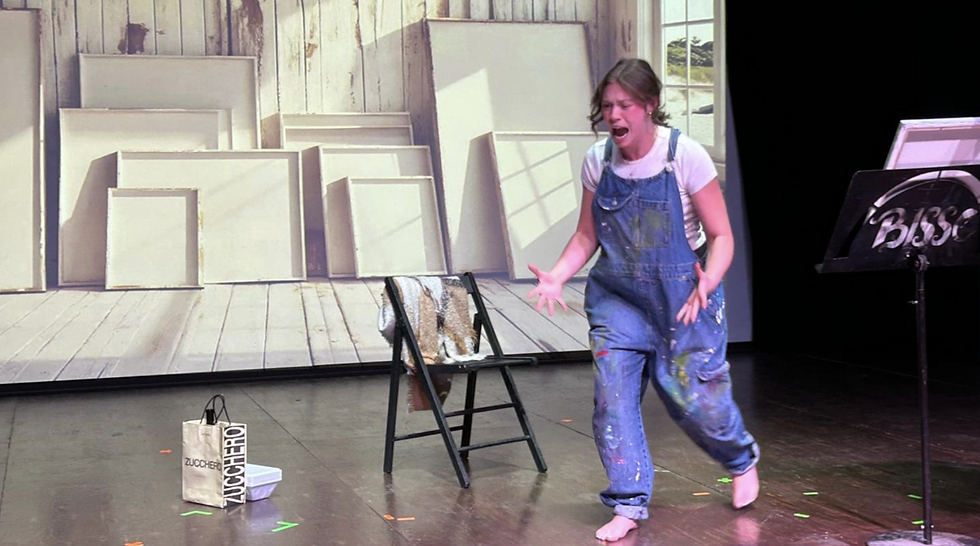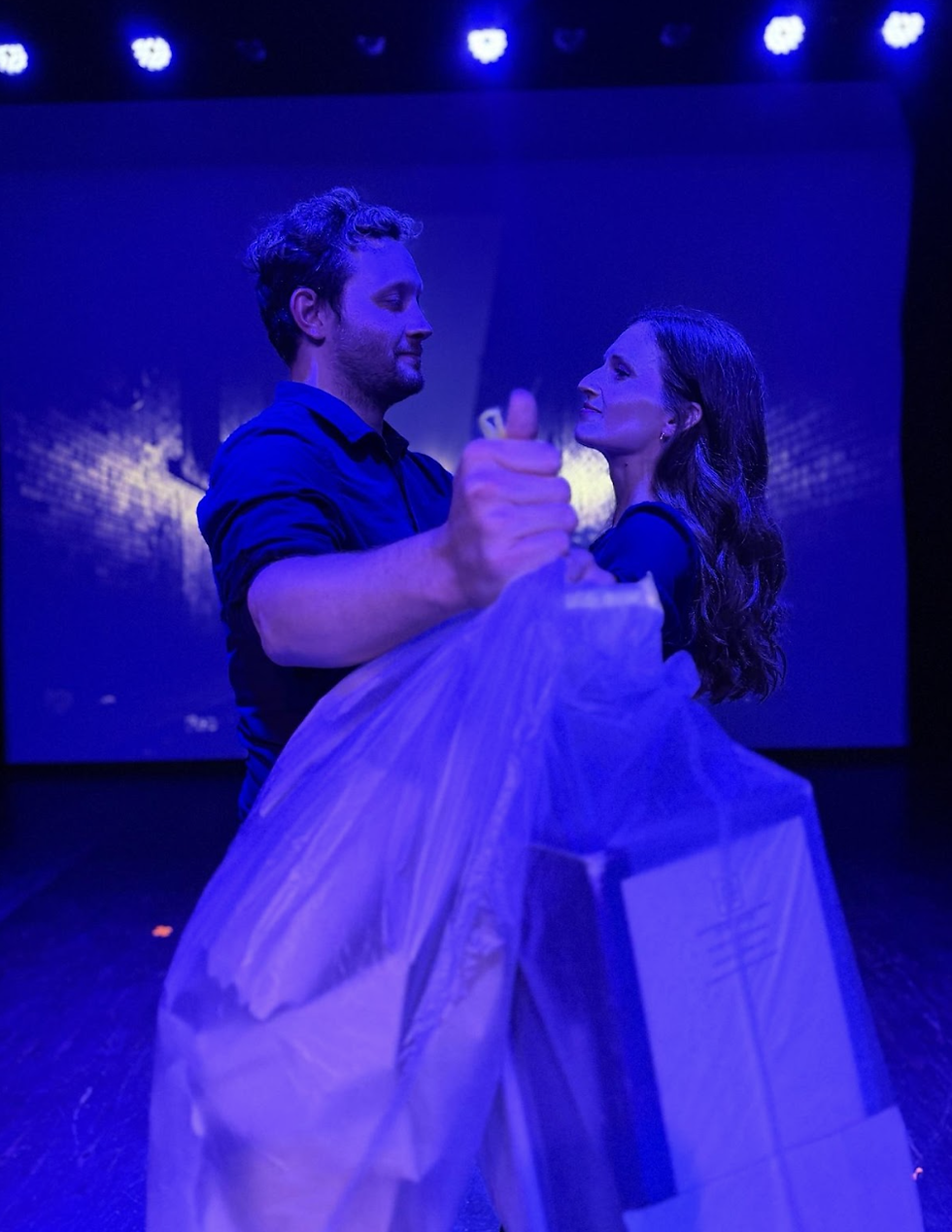The Puzzle: A new musical in the Spoleto Festival, Italy presented by La MaMa Umbria
By Alex Lefevre
Published:
July 1, 2025

The Puzzle is a new original musical with music and lyrics by Alex Lefevre, Assistant Professor of Theatre at Coastal Carolina University and libretto by Marybeth Berry, Associate Professor of Theatre at the University of South Carolina: Lancaster and received its European premiere in the Spoleto Festival in Spoleto, Italy as a part of the La MaMa Spoleto Open curated by La MaMa Umbria International in June 2025. The musical debuted in a developmental reading at Coastal Carolina University as a part of their new works series in May 2024. This production in Spoleto, Italy marked the first fully staged production of the musical.
The Puzzle takes place in Berlin, Maryland and tells the story of Jenna Adams, her mother Nanette, her six-year-old son Jake, and his two aunts Erica and Susan. In the opening number, “One Day”, the characters go through their daily routines until Jake’s father and Jenna’s husband, Scott, is killed in a car crash. Jake, overwhelmed by grief, is unresponsive until Jenna creates a song to accompany an old puzzle of Scott’s which serves as a breakthrough for the young boy. Nanette, the town busybody, sets up Jenna on a blind date with Taylor, a florist new to town. All goes well until Nanette suddenly bursts into their date and proclaims that her dog Mitzi has been injured by one of Jake’s puzzle pieces striking her in the eye. As a result, Nanette throws the puzzle in the trash, sending Jenna and Taylor on a date in the dumpster to successfully retrieve it. At the town’s fall festival, Jake begins to play the puzzle song by ear at the keyboard which Jenna attributes to the musical ability of her late husband and seeing it as a sign to move on. Through the course of the song “I Can Teach You”, Jenna and Susan convince Erica to teach piano lessons to Jake and over a decade passes highlighting major events including Taylor’s proposal to Jenna, the death of Mitzi, and Jake’s acceptance into NYU. At the end of Act I, it is revealed that Susan will be taking Jake to New York City and moving there herself as a part of a separation from Erica.
Act II begins with a married Taylor and Jenna now working together at the flower shop and Jenna sharing a secret passion: writing children’s books. Jake, a sophomore music major at NYU, is unsure that he wants to continue studying music as he feels he is living in the shadow of his deceased father. Susan travels with Jake to Maryland for spring break and is served divorce papers by Erica. At an explosive family dinner, chaos ensues when the impending divorce is revealed to the family along with Jake’s plan to take a gap year in Africa. Erica and Jenna storm out with Susan and Jake following behind. Susan takes responsibility for leaving and the couple vow to find a way forward, while Jake apologizes to Jenna who gives her unconditional love to her son. In the final scene, five years have passed, and Jake is now married with a child on the way. Erica and Susan are living in New York together, Jenna is a successful writer, Taylor has hired a new store manager, and Nanette has tragically passed away. Susan speaks at the opening of her latest art exhibit based on her family, gathered in support, entitled “The Puzzle”.
Marybeth Berry and I began writing The Puzzle in January of 2021. COVID-19 had crippled the theatre industry, and the world, and writing this show became our creative escape. We would meet weekly on Zoom to work and create weekly writing goals. We would start by discussing the characters and what we would ideally like to happen during a scene. The next meeting, we would read through the newly written scene, and I would choose moments that I felt would “sing” and began work on crafting a song. As our show is entitled The Puzzle, we attempted to shine the light equally on our different characters so that it was a true ensemble piece with each one of the characters representing a piece of our figurative puzzle. In the words of librettist Marybeth Berry, “It had been years of laboring to create the characters, the relationship dynamics and ultimately the story. Similar to Thornton Wilder’s Our Town, The Puzzle focuses on life, loss, grief, love pain, triumph and survival. We can all see ourselves in this piece and we can all relate to a character, relationship, or simple moment because, in the words of the show, ‘it’s often in the mundane that we find the momentous.’” Songs and scenes were constantly being tweaked but by the start of 2024, we had a strong working draft of the libretto and score. Coastal Carolina University selects a new musical every May to be developed as a reading in their New Works Series and The Puzzle was honored to be the selection for 2024. Adam Pelty, Associate Professor of Theatre, helmed the reading as the director and Micah Young was the Music Director. Through the course of one week of rehearsals, new songs and scenes were implemented and seeds of ideas for the Spoleto production were planted. In the original CCU reading, the character of Scott had already passed as we started our prologue. Pelty suggested that there would be great power if the audience could experience the death first-hand. After being accepted into the Spoleto Festival, a new opening number was written with the car crash and funeral embedded in the opening number. While the original lyrics of the opening number “One Day” were kept for the start with each of the characters describing their everyday routines, it now ends after the funeral with the characters singing lines like “One Day is just like the others until one day it’s not” and “One day I will wash his coffee mug, right now I can’t put it away”. For the production in Spoleto, three new songs were implemented as well as significant cuts to the book to streamline our storytelling. While The Puzzle runs two hours and 30 minutes including a fifteen-minute intermission, with our Friday night Spoleto performance starting at 9:30pm, ensuring that we were maintaining our running time was essential. Reflecting on the process of putting up this production, Shelby Sessler who played Erica says “Watching pieces get moved, added, and cut from the reading to the production itself was fascinating to watch. We were experimenting with how each scene read even up to our opening to find the right tone to tell the story. It felt like a whirlwind of creativity.” There was no better place to experience this whirlwind than La MaMa Umbria.

La MaMa Umbria is described on their website as a “non-profit cultural center and artist residence founded in 1990 by legendary theatre pioneer, Ellen Stewart.” Even with seeing all the photos available online, nothing can prepare one for the sheer beauty of this remarkable theatre space. Lisa Neal Baker who played the role Nanette shares “Every time we would return from an outing or a day of work, it felt like we were walking back into a serene fairytale- flowers blooming, birds chirping, butterflies everywhere with majestic mountains as your backdrop. With only eight days to come together to put this incredibly touching story together, having the calm, quiet serenity of La MaMa made it that much easier to focus, create and develop our characters and how their individual stories touched each other.” Actor Zach Hathaway, who played Jake, had previously performed at La MaMa Umbria in another production with Marybeth Berry. He states “Returning to La MaMa Umbria for the second time has been an incredibly special and fulfilling experience. There’s something truly magical about being in a space so deeply committed to nurturing artists and celebrating the craft of performance. Ever since my first time here three years ago, I’ve longed to return to that creative atmosphere, where collaboration and artistic exploration are at the heart of everything.” The staff of La MaMa Umbria ensured that our experience would be a positive one. They welcomed us with open arms, provided phenomenal meals with ingredients often plucked out of their on-site garden, and even splashed our bus with buckets of water as we pulled out of their driveway as a symbol of safe travel and hopefully an eventual return. Kenley Juback, who played Susan, echoes this sentiment: “Not only is the scenery irrevocably beautiful but so are the people. The love, friendship and artistry that finds you here from the La Mama Umbria staff is rare.” In fact, our performances of The Puzzle were filled with staff from La MaMa Umbria who came to support our work and promote new musical theatre. Known primarily for producing experimental theatre, La MaMa Umbria embraced our show in an astounding way. Director Jason Trucco, who was also in residence at La MaMa Umbria with us stated “I think the most experimental thing that can be done at an experimental theatre today is a Broadway musical.”
Performing in a festival brings its own set of unique challenges, especially when it comes to the technical aspects of performance. In order to create the different locations, present in The Puzzle, we decided to turn to projections to set the scenes in addition to basic set pieces. According to Hans Boeschen, our stage manager and technical director, “The idea of projections arose from the challenge of visualizing the final scene which reveals an art gallery. The idea of this gallery installment is so unique that a projection was really our only option to capture the symbolism and heart of the moment. Using various A.I. tools, I worked to create backgrounds that not only helped identify the setting, but, hopefully, reflected the aspects of the characters and underlying themes of the book.” The use of A.I to create backgrounds was not a simple process as rarely did the computer outputs match what we as a team had in mind artistically. However, there were some happy accidents that occurred in the creation of the projections. Boeschen explains “Unintended interpretations from the computer could lead to some interesting deeper symbology. For example, Susan’s character struggles to connect with her art early in the production. I had asked A.I. to include blank canvases lying against the wall. Instead, it gave me an image where all the canvases were turned away and all we saw were their backs, almost as though Susan couldn’t bear to look at them.” The final projection of Susan’s art gallery display proved be the most difficult. No matter how precise the description we provided the computer, it could not produce anything with the necessary heart to culminate our piece. In the end, it was the original paintings of our cast member Shelby Sessler who played Erica, that we were able to scan into the computer to create the final images of Susan’s art instillation.
Even with a simplified set, transitions between scenes still proved to be a challenge. We initially had our actors dragging tables and chairs from backstage before and after every number. Not only did this prove to be laborious, but also time consuming. Director Jared McNeill, also in residence at La MaMa Umbria, came to one of our early runs and provided the suggestion that we leave the set pieces on the side of the stage and allow our audience to see the actors putting together the set as they would put together the pieces of a puzzle. This brilliant suggestion not only helped us to facilitate our transitions in a more efficient way, but it also aided in our storytelling. Our actors began to see the transitions not just as necessary stage business but as extensions of their characters. Actor Alex Cowsert who played Taylor says “It was important for me to continue the story forward when assisting with scene transitions by remaining in the correct time period for the show. For example, if I was helping with a transition in the second act, I wanted to keep my older Taylor’s glasses on so it wouldn’t seem I was ‘out of character’.” Being at La MaMa Umbria allowed us as a creative team to get input from international directors like Jason Trucco and Jared McNeill. Their creative questions and ideas sparked many conversations about the next iteration of this musical for which we as authors are incredibly grateful.

The final piece of the puzzle of any theatrical work is always the audience, which in the case of this production, was Italian. While there is a song with a chorus in Italian, “Bambola Mia”, The Puzzle is a musical that is performed in English. Adriana Garbagnati, part of the La Mama Umbria family and an enormous supporter of our show, suggested that we write a synopsis of the show and provide copies to the audience much as one would receive at an opera. Blaize Berry, son to librettist Marybeth Berry and technical assistant for the production, wrote a thorough synopsis of the show that I then translated into Italian. Though most of our audience had a basic facility with English, the synopsis proved to be useful as we noted many of our audience members following along as the show progressed. Even with the added challenge of the show being performed in English, our audiences were still able to be moved by the show as was evidenced by the sniffles and tears present during our run. Librettist Marybeth Berry states “The themes in this show resonate with all walks of life and all cultures. The language barrier taught us that our show has more to offer than just entertainment. It touches others deeply and profoundly. Audience members recognized their own loved ones and own life experiences in our creation. It was a gift that transcends all typical barriers because of its simplicity.”

The Puzzle has had an incredible journey from our living rooms in South Carolina on Zoom to the stage of La MaMa Umbria as a part of the Spoleto Festival in Italy. Actor Katie Gatch who played Jenna, said that working on a production of a new musical “felt like a door popping into existence in front of me, the threshold uncrossed, and I get to be the one to see what’s on the other side.” With the support of La MaMa Umbria, we certainly were able to see what’s on the other side, and it was thrilling. Writing and producing a new musical is a complicated process, but one that is ultimately highly rewarding. After this run, The Puzzle, or Il Puzzle as it was called in Italy, has only just begun to have its pieces assembled.
Image Credits:
References
About the author(s)
Alex Lefevre (composer/lyricist The Puzzle) is an Assistant Professor of Theatre at Coastal Carolina University in Conway, SC. He has played on Broadway in the orchestras of Aladdin, Anastasia, Beetlejuice, Cats, Newsies, and White Christmas, along with work Off-Broadway including The Fantasticks and Avenue Q and on national tour with Anastasia, Hairspray, and Irving Berlin’s I Love a Piano. An avid proponent of new musicals, Lefevre has music directed productions in both the New York Musical Theatre Festival and New York Fringe Festival as well as at 54 Below, The York Theatre Company, Primary Stages, and Ars Nova. As a composer, his work has been featured in the NEO Concert at the York Theatre Company celebrating New, Emerging, and Outstanding musical theatre writers as well as in the San Diego Fringe Festival, the Scranton Fringe Festival, the New Works Series at Coastal Carolina University and La MaMa Umbria. For the past three years, Lefevre has served as an opera coach for Varna International both in the United States and Italy, working on Mozart’s Don Giovanni, Puccini’s Suor Angelica, and Weill’s Street Scene.
European Stages, born from the merger of Western European Stages and Slavic and East European Performance in 2013, is a premier English-language resource offering a comprehensive view of contemporary theatre across the European continent. With roots dating back to 1969, the journal has chronicled the dynamic evolution of Western and Eastern European theatrical spheres. It features in-depth analyses, interviews with leading artists, and detailed reports on major European theatre festivals, capturing the essence of a transformative era marked by influential directors, actors, and innovative changes in theatre design and technology.
European Stages is a publication of the Martin E. Segal Theatre Center.


